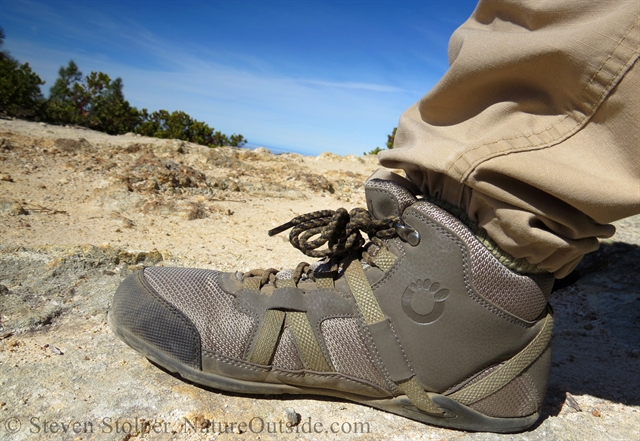
UPDATE: I no longer recommend these boots. Please read the update at the bottom of this review.
There is no shortage of hiking boots on the market. And more or less, they’re all the same.
But minimalist hiking boots are different, and gaining in popularity. So, let’s look at the Xero Shoes Daylite Hiker, minimalist hiking boots I’ve been wearing for the past five months.
What are Minimalist Hiking Boots?
Foot health is at the center of the minimalist shoe craze. We walk differently when we wear shoes than when we’re barefoot. And modern shoes force us to walk in ways that can put a lot of stress on our feet and spine.
Minimalist shoes are designed to let your feet move in a healthier way. And minimalist hiking boots share several features with minimalist shoes.
Zero Drop
Minimalist hiking boots have a flat heel.
Most modern hiking boots have a raised heel. A raised heel changes the alignment of your body when you walk and puts stress on your legs, hip, and back. It can cause the Achilles tendon to tighten and shorten, and puts more pressure on the balls of your feet. This can also stress the foot’s natural padding and lead to calluses.
Lightweight
Minimalist hiking boots are lightweight.
The Daylite Hiker weighs only 10.2 ounces (each) for a Men’s Size 9. I normally wear the Lowa Renegade GTX hiking boot. The Lowa Renegade is a terrific boot and lightweight for its class. But they weigh around 1 pound 3 ounces (each). So the Daylite Hikers are quite a bit lighter – almost half the weight of the Lowa!
There’s an old saying among hikers: A pound on your feet is like five on your back. This is because your muscles lift and lower your boots with every step. So minimalist boots are not only packable in your luggage, they’re easy to hike in because they’re so lightweight.
A pound on your feet is like five on your back.
Large Toe Box
Minimalist hiking boots have a large toe box. This permits your toes to expand as they would if you were walking barefoot.
Do you have feet that narrow toward the front (your big toe points outward) because your shoes scrunch your toes together? By contrast, when you wear minimalist boots your toes feel liberated.
Occasionally, you read a snarky comment on the Internet that they’re shaped like “clown shoes.” But don’t let that dissuade you! The wider toe box on minimalist hiking boots is barely noticeable, and only to people who look closely.
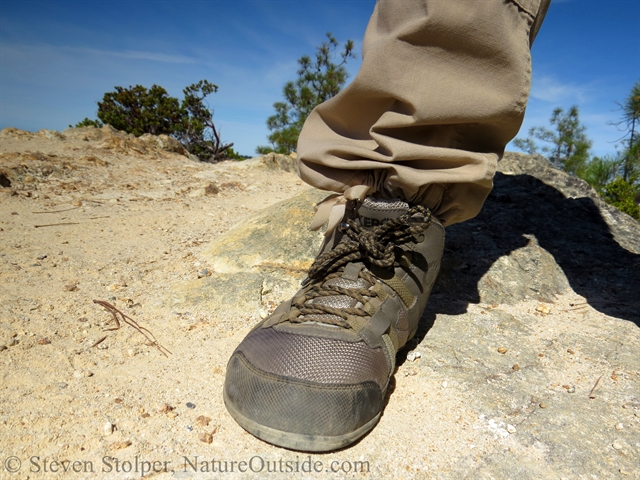
The Daylite Hiker has a roomy toe box that allows your toes to move and work while you hike.
Thin Sole
Minimalist hiking boots have a thin sole.
For me, the thin sole is part of the allure of minimalist boots. I do a lot of animal tracking and nature observation. The soles put me in touch with the ground and allow me to Fox Walk silently through the forest. It’s a nice change from clomp-clomp-clomping down the trail in traditional boots.
Minimalist hiking boots try to offer the protection of a shoe and the feel of a moccasin. Like moccasins, you feel more attached to your environment. And I find they give me a more intimate connection with nature.
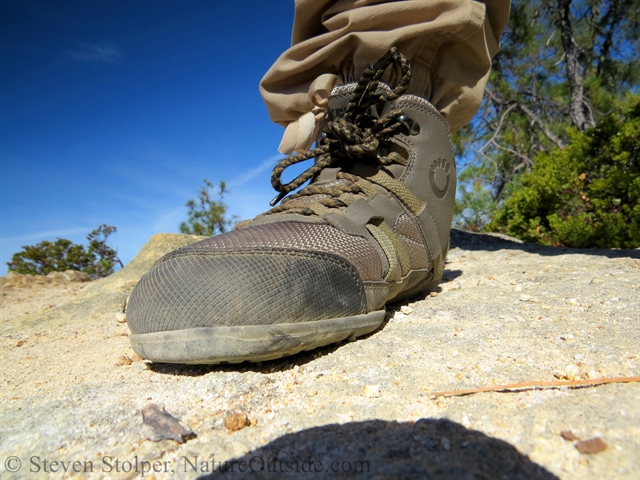
The Daylite Hiker has a six millimeter thick sole that allows you to feel the earth under your feet.
Flexible
The thin sole allows minimalist hiking boots to flex. Your foot moves more naturally as you walk.
I find the minimalist boots help my proprioception. Proprioception is your brain’s awareness of the position and movement of the body. Now that my feet are flexing as I walk, the nerves in my soles seem to give me more feedback, helping my balance.
Modern hiking boots, by contrast, have rigid footbeds. Your foot muscles do not work as hard in traditional boots, and this rigidity helps when you carry heavy loads. In minimalist boots, your foot muscles work harder as you hike over uneven terrain. And you need to be prepared for this. The good news is that you don’t get any of the foot soreness that comes from hiking all day on a rigid platform.
Also, the rigid footbeds found in traditional boots stretch the plantar fascia and can lead to Plantar fasciitis. In some people, it also aggravates Achilles tendinitis due to poor foot mechanics.
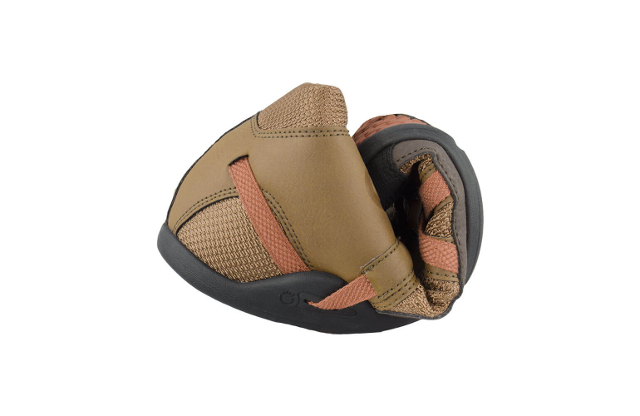
The Daylite Hiker is lightweight and flexible. Photo courtesy of Xero Shoes.
Why I tried Minimalist Hiking Boots
Several years ago, I rendered assistance during a minor emergency in the wilderness. I ran six miles down a steep mountain wearing traditional hiking boots and carrying a heavy pack. All in all, I hiked 13 miles that day. When I wasn’t running, I was hiking across steep terrain at full speed. We rescued the person who needed help, but I suffered injuries to both feet in the process.
From that day, normal hiking boots cause me pain and sore feet. It sucks the fun out of hiking. I tried more rigid boots. I tried insoles with extra arch support. Nothing worked. If the arch was too high, it transmitted stress to my knees. If the arch was too low, plantar fasciitis. I couldn’t find a solution that worked.
In desperation, I hatched a plan. Instead of searching for footwear to accommodate my situation, I would strengthen my feet instead! I perform daily exercises to strengthen the muscles of my feet. And although the exercises help, I still experience foot pain while hiking.
Minimalist hiking boots were part of my plan. It seems counterintuitive that minimalist hiking boots helped me. They lack the raised heel and arch support doctors told me I needed. But it turns out they are perfect for my feet. The boots allow my feet to flex and move in a more natural way. And the pain disappeared.
The Xero Shoes Daylite Hiker
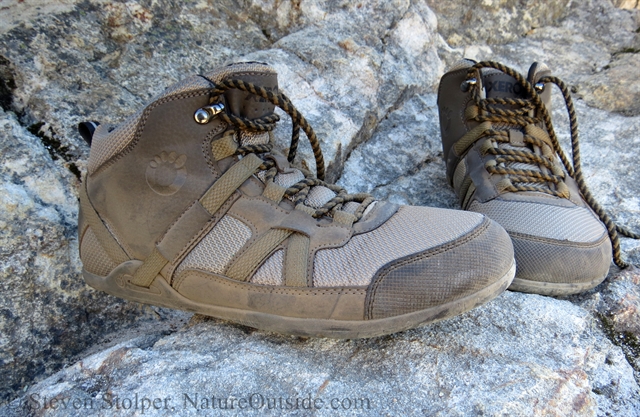
The Xero Shoes Daylite Hiker
The minimalist boots I wear are the Xero Shoes Daylite Hiker. And I spent the last five months using them in a variety of conditions. The boots aren’t appropriate for all situations and for all people, as I’ll explain below. But maybe they’ll meet your needs.
The sole of the Daylite Hiker is six millimeters thick (thin). And the nylon upper is given rigidity by a Huarache-inspired set of straps around the heel and the instep.
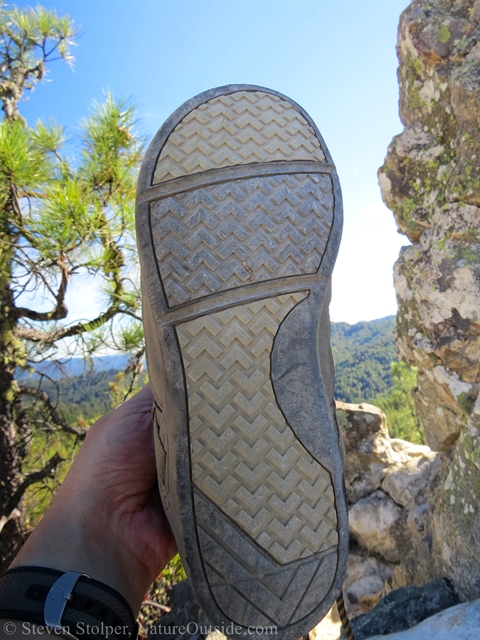
The thin sole gives a good feel for the ground. But it lacks traction over some types of terrain.
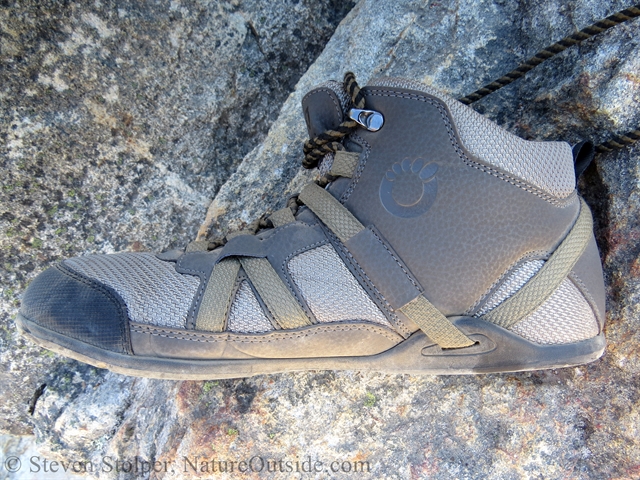
The boot is mid-rise with a nylon upper and webbing for support.
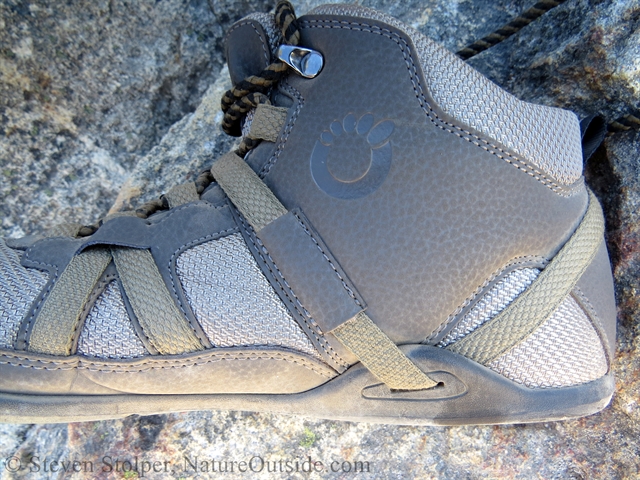
A closer look at the webbing
Wearing the boot is closer to wearing nylon running shoes than to traditional leather hiking boots. And it’s a pleasant feeling to put them on.
Sizing
The Daylite Hiker runs small. The Xero Shoes website recommends choosing one full size larger than your usual size. Heed their advice! I wear an 8.5 (US Men) cross-trainer and a 9 (US Men) hiking boot.
I ordered full-size up (9.5 US Men) and was able to fit comfortably while wearing Gobi sock liners and Thorlo hiking socks. Without the liners and hiking socks, the boot would have been slightly too large.
Flat Terrain
As I mention above, one of the benefits of the Xero Shoes Daylite Hiker is that you sense the trail underfoot. The lightweight boots feel great, and land somewhere between walking barefoot and wearing light hiking boots.
The boot provides some ankle protection. But because it is not rigid, your ankle can flex easily. So these boots may not be appropriate if you are prone to ankle sprains, or plan to carry loads exceeding twenty pounds.
Feeling the terrain has its drawbacks. It can be tough to walk on large gravel sometimes found on California’s unimproved dirt roads. If the gravel has sharp points and edges, you’ll feel them. It doesn’t hurt, but it does slow your progress slightly.
Occasionally, you may strike a large rock with your instep. In traditional boots, you would hardly notice. But in the Daylite Hiker you get a momentary pain sensation that disappears as fast as it comes. As a result, your brain becomes more selective about where you place your feet. And you are more attuned to the terrain you’re walking over.
Uphill Hiking and the Adjustment Period
IMPORTANT: If you not accustomed to zero drop shoes, your calf muscles will work overtime when you start to wear them. The zero drop sole stretches your calf muscles compared to boots with a raised heel. So when you first wear them, start with small hikes.
IMPORTANT: If you not accustomed to zero drop shoes, your calf muscles will work overtime when you start to wear them. They will be sore!
During the first two months I wore Daylite Hikers, my calf muscles complained after hikes the way they did when I was new to hiking. It’s the “healthy” kind of muscle soreness you get after a big workout at the gym.
Be prepared for this adjustment period. The day after a big hike, you may find yourself shuffling around like an old man!
During the adjustment period, I found walking uphill much more taxing than in traditional boots. I have two theories why this happened.
The first is that, without the raised heel, my foot was more inclined to the terrain. The raised heel shallowed the angle my foot assumed as I attacked the hills. Without the raised heel, my calf muscles stretched more than with traditional boots.
My second theory is that my foot flexes more in the Daylite Hiker than in more rigid traditional boots. While this makes the Daylite Hiker comfortable during hikes, my calf muscles worked much harder than with a rigid footbed. So be prepared. Until your calf muscles adjust to the added workload, they will be sore afterwards.
Downhill Traction
Downhill traction is fine in most circumstances. But loose rocks on the trail are a problem. Traditional boots have a heavy rubber lug sole. The lug sole catches and holds scree on the trail. With the Daylite Hiker, your foot flexes around loose rocks. If the rock is sharp you need to be careful.
I don’t see this as a major problem. I found myself lighter on my feet and distributing my weight better when traveling downhill on loose rock. My brain also began to be more selective about my route. If you are accustomed to powering your way through all terrain, you may be better off staying with traditional boots.
Traction on Rocks
The first time I walked up smooth granite, I was surprised by the Daylite Hikers’ grippy-ness. Then I tried to sit down! The moment my full weight shifted from over my soles, my feet slid out from under me and I landed on my rear with a bump. These boots want to slide! They’re even worse than wearing sneakers with worn soles. These boots can literally trip you up, if you’re not careful.
The Daylite Hikers fall short on traction. The rubber outsole is too slippery on rock surfaces. I will not wear them in Yosemite. And I’ll wear my traditional boots whenever there’s a chance I’ll be hiking on wet rock.
Sandstone is less of a problem. But traction is still an issue. I climbed a steep sandstone rock face and the boots did fine. But I slipped as I descended the shallow backside.
Also, because the soles are flexible, you cannot wedge your feet between rocks to “create a step.” If you try, the sole will flex and you’ll find your foot has slipped into the gap between rocks. I actually trapped my foot momentarily the first time I tried it.
Bushwhacking
The boots performed well while bushwhacking. They feel more like lightweight running shoes than heavy leather boots. But the nylon upper turned away thorns and was not bothered by dirt and dust. As I mentioned earlier, traction can be an issue on loose rock and smooth surfaces. But I felt confident bushwhacking in the Daylite Hikers.
Rain and Mud
The Daylite Hiker lacks a breathable waterproof lining. So I don’t recommend them for snow or heavy rain. And as I mention above, wet traction on hard surfaces is an issue.
I wore the boots in rain several times and the nylon upper kept my feet surprisingly dry. After about six miles my socks were only slightly damp. But I also steered around ankle-deep puddles that I would not have even noticed with traditional boots.
Mud performance was surprisingly good. I hiked through a swampy area where my feet sank until the mud covered the entire upper. My socks stayed dry and the mud flaked off after it dried in the sun. As I mention earlier, traction is a problem. So you need to be aware of areas where shallow mud coats hard surfaces.
These are not all-weather boots. But for local day hikes lasting several hours, they are plenty fine in rain and mud.
Putting Them On
The Daylite Hikers have a strange idiosyncrasy. They’re hard to put on. When you insert your foot, the collar of the flexible upper collapses into the boot. There is a pull loop/tab on the back of the boot, just below the collar. But it’s too small for an adult to slip a finger through and much too small to grasp between your thumb and index finger.
So I always wrestle with the boots trying to put them on. Ultimately, I surrender and loosen the laces all down the boot. Only then can I open the collar with my hands to insert my foot. This is quite an annoyance!
Conclusion
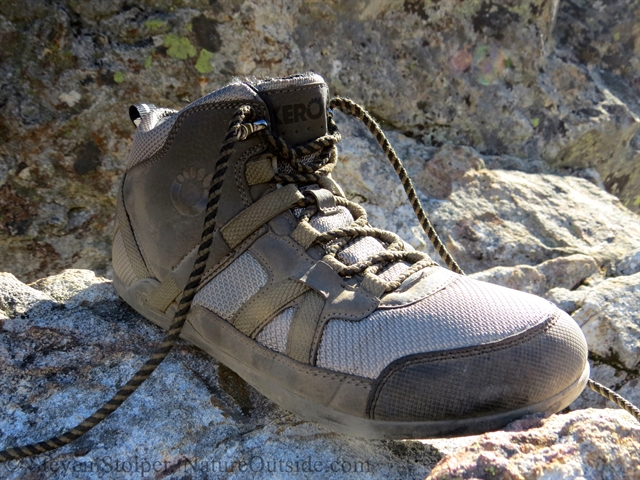
I’ve grown to love the Daylite Hiker for what it is, and accept it for what it is not. They’re extremely comfortable and I no longer experience the foot pain I felt with traditional boots. My feet are stronger because they flex more when I hike. And I love the feeling of contact with the ground.
The Daylite Hiker is best for short day hikes (4-8 miles) where you carry a pack weighing less than twenty pounds. I don’t recommend these boots for backpacking, where you carry a much heavier pack and need a more rigid, supportive boot. Nor will I use them on unknown terrain, as the traction can be poor on smooth or gravelly surfaces.
The boots come in several colors. I like the unobtrusive olive drab. But the brown looks OK too.
Have you tried minimalist hiking boots? Let me know what you think in the comments section, below.
Update
I no longer recommend the Daylite Hiker boots. While descending a trail wearing these boots, I slipped and fell. I landed on my left foot, breaking it in several places.
The Daylite Hiker’s slippery rubber sole contributed directly to the accident. The sole could not maintain traction on the redwood needles and other debris on the trail. My injury was made worse because the flexible boot did not protect my foot as I fell on top of it.
These boots create a slipping hazard. I now feel the boots place the wearer at unacceptable risk. I still wear minimalist shoes in urban environments. But I no longer recommend wearing Daylite Hiker boots on the trail.
Related Articles on NatureOutside
10 Books forBushcrafters, Nature Lovers, and People Who Love the Outdoors (2018)
Bug Off! How to Choose an Effective Mosquito Repellent
My most popular first aid supply of the year!
For fun facts and useful tips, join the free Bushcraft Newsletter.



Hi Steve, Nice article on the Daylite Hikers. I used a pair of Keene’s that were very light and flexible. I ended up setting them aside as I developed pain with my arches. I went back to a new generation Vasque boot which is lighter than earlier versions. Hal
When I wear conventional boots, I look for lightweight and rigid. The rigidity is important for good support and allows me to carry heavier weight. I find that with a conventional boot, if it is “semi-flexible” I also experience arch pain.
So it may seem counter-intuitive that I like minimalist boots, which are not rigid at all. My belief is that it is healthy for your foot to flex when you walk. And that it helps to strengthen your feet. The minimalist boots have little to no arch support, and strangely enough I have no arch pain when I use them.
I expect everyone will be different. So your mileage may vary.
Hi Steve,
Excellent review. Detailed and informative. …exactly what I have been searching the web for. I am a photographer in New England who hikes 4K mountains and bushwhacks to remote waterfalls in the rain while rock hopping in wet rivers. I need solid traction on wet rock. I don’t want to fall carrying expensive camera gear. So thank you for the detail on that subject. I love my old vivobarefoot hiking boots but the soles wore out on both pairs and are now slippery. I am looking for new minimalist boots. There aren’t many options.
I’m glad you found the review helpful, Michelle. Good luck with your search for minimalist hiking boots that provide great traction. Let me know what you find.
A shoe or boot based on a good “last” close to the shape of one’s foot is what rid me of feet pain after standing or walking most of the day.The athletic or outdoor lightweight shoes are too generic and feel like the soles are lined with cardboard or newspaper. They soon become sloppy on top and inside. I’ve gone back to a well constructed leather walking shoe like they used to make in England. However, I can’t recommend a brand anymore and will be looking at custom made leather shoes.
HW, thank you for sharing your experience with English walking shoes.
Completely agree with you on the traction issue 🙁
I like the fact that they are so lightweight, but they do put you actually in danger.
Do you have an hypothesis why is this happening? is it a material quality or a sole profile geometry in your opinion? I’m looking for a post-production modification that may improve the performance but don’t yet quite get it. It seems to me the profile allows for a limited contact point surface area where all the force is distributed (these “arrows”): once you load enough force the friction is just not enough to hold and breaks through all at once with no cooperative gripping action.